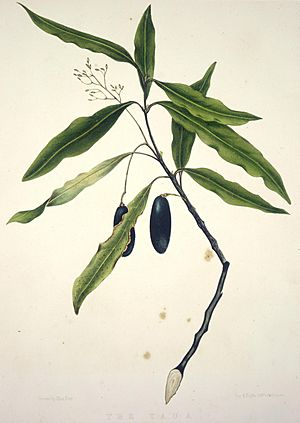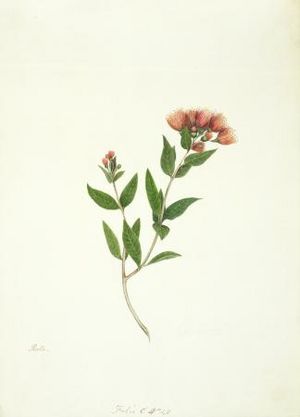Martha King facts for kids
Quick facts for kids
Martha King
|
|
|---|---|
| Born | c.1803 Ireland
|
| Died | (aged 94) New Plymouth, New Zealand
|
| Known for | Botanical Art |
Martha King (born around 1803 – died May 31, 1897) was a very talented artist. She was New Zealand's first resident botanical illustrator. This means she was the first person living in New Zealand to draw plants for scientific purposes. Martha was also important in the early towns of Whanganui and New Plymouth. She helped start schools in both places. She was a great gardener and a dedicated teacher.
Her Life Story
Martha King was born in Ireland in 1802 or 1803. She moved to New Zealand in December 1840. She arrived in Wellington on a ship called the London. Martha traveled with her older sister, Maria, and her brother, Samuel Popham King.
From Wellington, the King family sailed to Whanganui. They arrived on February 27, 1841. They were among the first people to settle in the new town. Samuel King built two houses. Soon after, Martha and her sister opened Whanganui's first school. People said the school was very popular. The sisters were good at being both strict and kind.
In December 1847, the King family moved to New Plymouth. Martha opened another school there with her sister Maria. Their sister-in-law, Mary Jane King, also helped. This school building was also used for other events. These included dances and cultural activities. This shows how important the King family was in New Plymouth. Both sisters also wove flax. They made cloth, bags, and other items to earn extra money. Martha also created a "fine garden." She was sad to leave it when she moved to Auckland for safety. This was during a conflict called the First Taranaki War in 1860–1861.
Martha King died at her home in New Plymouth on May 31, 1897. She was 94 years old.
Her Artwork
Martha King was one of the early settlers who drew plants. She did this to help make a living in the new country.
In September 1842, Martha was asked to draw plants. The Wellington Horticultural and Botanical Society gave her this job. She was to make two sets of drawings of interesting New Zealand plants. One set was for the New Zealand Company in London. The other was for the London Horticultural Society. We don't know why Martha was chosen for this special task.
The first set of 40 watercolor paintings was finished by January 1843. It reached the New Zealand Company in London later that year. This set of drawings is now kept at the Alexander Turnbull Library. The second set of drawings has never been found.
In 1845, four of Martha's drawings were used in a book. The book was called Illustrations to Adventures in New Zealand by Edward Jerningham Wakefield.
Besides her plant watercolors, only 16 pencil sketches remain. These sketches show scenes from Wellington, Whanganui, and New Plymouth. They were drawn between 1841 and 1859. Martha also showed her work at the Sydney International Exhibition in 1879. However, no other examples of her artwork are known to exist today.
How She Is Remembered
In 2017, Martha King was honored by the Royal Society Te Apārangi. She was chosen as one of their "150 women in 150 words". This celebrated the important things women have done for knowledge in New Zealand.



